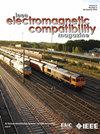A Novel Decoupling Method to Reduce Radio Frequency Interference (RFI) Noise From High-Speed Connector
IF 2.5
3区 计算机科学
Q3 ENGINEERING, ELECTRICAL & ELECTRONIC
IEEE Transactions on Electromagnetic Compatibility
Pub Date : 2025-07-01
DOI:10.1109/TEMC.2025.3580282
引用次数: 0
Abstract
This article proposes an innovative method to effectively suppress radio frequency interference (RFI) noise from a high-speed differential channel passing through connectors. The proposed method uses a decoupling network (DN) to eliminate common-mode (CM) radiation generated from a high-speed connector to a nearby antenna. The DN comprises a six-port coupler on the connector side, a four-port coupler on the antenna side, and a phase delay line. This article presents the design concept, detailed signal flow graph analysis, and a step-by-step design procedure for implementing the DN. To demonstrate the effectiveness of the approach, a DN was designed and implemented for a universal serial bus (USB) 3.0 connector and a planar inverted-F antenna operating at 2.475 GHz. Both simulation and measurement results are presented, showing good agreement. The implemented DN achieved about 25-dB reduction in CM noise coupling at the target frequency and at least 10-dB reduction over a wide frequency range from 2.43 to 2.55 GHz. This validates the outstanding performance of the proposed method in mitigating RFI issues in compact electronic devices with high-speed interfaces. Furthermore, the proposed DN does not affect the normal operation of both the antenna and the high-speed differential signals.一种降低高速连接器射频干扰(RFI)噪声的新型解耦方法
本文提出了一种创新的方法来有效地抑制通过连接器的高速差分信道的射频干扰(RFI)噪声。该方法使用解耦网络(DN)来消除高速连接器对附近天线产生的共模(CM)辐射。该DN包括连接器侧的六端口耦合器、天线侧的四端口耦合器和相位延迟线。本文介绍了设计概念,详细的信号流图分析,以及实现DN的逐步设计过程。为了验证该方法的有效性,设计并实现了通用串行总线(USB) 3.0连接器和工作在2.475 GHz的平面倒f天线的DN。仿真结果与实测结果吻合良好。所实现的DN在目标频率下实现了CM噪声耦合约25 db的降低,在2.43至2.55 GHz的宽频率范围内实现了至少10 db的降低。这验证了所提出的方法在减轻具有高速接口的紧凑型电子设备中的RFI问题方面的卓越性能。此外,所提出的DN不影响天线和高速差分信号的正常工作。
本文章由计算机程序翻译,如有差异,请以英文原文为准。
求助全文
约1分钟内获得全文
求助全文
来源期刊
CiteScore
4.80
自引率
19.00%
发文量
235
审稿时长
2.3 months
期刊介绍:
IEEE Transactions on Electromagnetic Compatibility publishes original and significant contributions related to all disciplines of electromagnetic compatibility (EMC) and relevant methods to predict, assess and prevent electromagnetic interference (EMI) and increase device/product immunity. The scope of the publication includes, but is not limited to Electromagnetic Environments; Interference Control; EMC and EMI Modeling; High Power Electromagnetics; EMC Standards, Methods of EMC Measurements; Computational Electromagnetics and Signal and Power Integrity, as applied or directly related to Electromagnetic Compatibility problems; Transmission Lines; Electrostatic Discharge and Lightning Effects; EMC in Wireless and Optical Technologies; EMC in Printed Circuit Board and System Design.

 求助内容:
求助内容: 应助结果提醒方式:
应助结果提醒方式:


